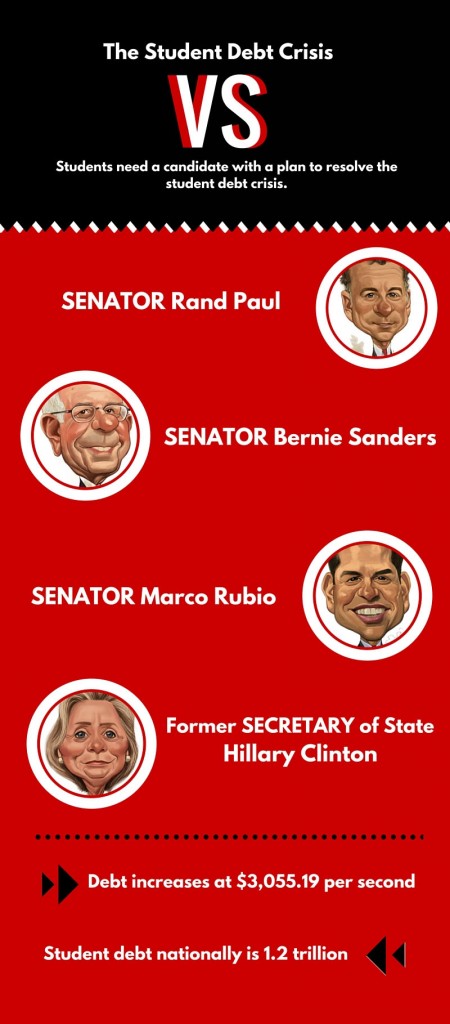Left Wing
Written by Zenobia Harris, Copy Editor
The student debt crisis is a growing problem in America. According to the Federal Reserve, the current student debt amount is growing at a rate of about $3,055.19 per second; so it is easy to see why students should be concerned about what the 2016 presidential candidates plan to do about this issue.
Hillary Clinton’s plan, which has been called the “New College Compact”, will allow students to go to college without having to take out loans. This plan would also make in-state tuition cheaper, applying for aid and repaying loans (for current borrowers) simpler and easier. While Clinton would not make college completely free, Democratic senator, Bernie Sanders, has proposed a $70 billion-a-year plan that would allow students to attend college for virtually nothing.
Republican senator, Marco Rubio, has a plan that may not be as innovative and “revolutionary” as he would like for people to believe. The bulk of his proposal—to allow private investors to pay for a student’s tuition and gain a percentage of the student’s earnings after college—has already been suggested by another Republican presidential hopeful, Governor Chris Christie.
The problem with Rubio’s borrowed plan is that private investors may not pay for students in certain career fields like teaching, nursing, social work, etc. These are jobs that are extremely important to our society, but they would generate little profit for private investors. Some investors in support of the plan have even suggested taking up to 25 percent of students’ earnings for years after they’ve entered the workforce, according to an article from Think Progress.
Paying off these private investors could pose more of a problem than our current federal loan programs; especially when considering the amount of money it would take for a student to establish a life for themselves after graduation. Plus, the money being returned to investors wouldn’t be going back towards education, but straight into the hands of the rich.
Senator Rand Paul has expressed similar sentiments when it comes to “privatizing” education, and he is also a fan of ridiculously large classroom ratios (think a million to one), as he expressed at Vanity Fair’s New Establishment Summit back in 2014. This focus on what is “profitable” versus what will benefit American students is part of the reason why many believe that right-wing politicians are more concerned with making money for the wealthy rather than the millions of other Americans; people who work just as hard, but for some reason, still don’t make enough money to be considered important.
Right Wing
Written by Dillon Rountree, Staff Writer
Student debt in the United States is 1.2 Trillion dollars, with numbers like this, it is easy for us to call for radical action such as spending another 350 Billion dollars to try and alleviate student debt from the top down with the public’s money. This is what, former Secretary of State Hillary Clinton proposes. Some politicians have even proposed radical solutions such as making all public universities free for all students who qualify, as Senator Sanders has proposed.
These proposals may look appealing, but when these plans are examined, it is plain to see that they cannot work. A key factor in the increase in the costs of college is the mass influx of government subsidized loans. In fact, for every dollar of increase in government loans, there has been a 65 cent increase in the costs of college. A mass increase in funds will only increase the costs of college, as universities will be free to charge more. This model of funding may alleviate student debt, but will increase the burden on all American taxpayers while government debt is already 18 trillion dollars.
Instead of throwing more money at the problem as some would do, one must instead look at ways to alleviate the burden of student debt through the use of smart policy. Both Senator Rand Paul and Senator Marco Rubio are proposing policy that would help take the stress off students and reduce the specter of finical ruin caused by student loans.
Senator Rubio is currently cosponsoring a Senate Bill that focuses on a retooling of the current government loan system that would simplify the process for students and make it easier to repay their student loans and avoid financial hardship. In addition to this bill, Senator Rubio has proposed a system of private investment for students in which investors could sponsor a student’s education in exchange for a portion of the student’s income upon graduation. Senator Paul’s comments on student debt have been about easier repayment through tax write offs on student debt payments, something that would eliminate much of the financial burden for many graduates.
In conjunction with reduced government spending overall, these plans will make college affordable for more Americans, and will do so without adding another untold billions of dollars to the national debt.
 The Spectator The independent student newspaper of Valdosta State University
The Spectator The independent student newspaper of Valdosta State University





